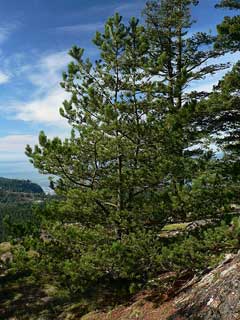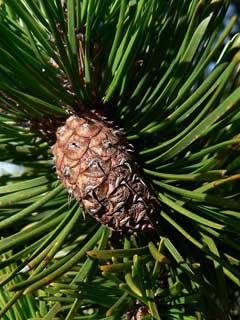 |
|
http://en.wikipedia.org/wiki/User_talk:Wsiegmund |
 |
| http://en.wikipedia.org/wiki/User_talk:Wsiegmund |
Translate this page:
Summary
Bloom Color: Yellow. Main Bloom Time: Early spring, Late spring, Mid spring. Form: Columnar, Pyramidal.
Physical Characteristics

 Pinus_contorta is an evergreen Tree growing to 15 m (49ft) by 8 m (26ft) at a fast rate.
Pinus_contorta is an evergreen Tree growing to 15 m (49ft) by 8 m (26ft) at a fast rate.
See above for USDA hardiness. It is hardy to UK zone 7. It is in leaf all year, in flower in May, and the seeds ripen from January to February. The species is monoecious (individual flowers are either male or female, but both sexes can be found on the same plant) and is pollinated by Wind. The plant is not self-fertile.
Suitable for: light (sandy) and medium (loamy) soils and can grow in nutritionally poor soil. Suitable pH: mildly acid and neutral soils. It cannot grow in the shade. It prefers dry moist or wet soil and can tolerate drought. The plant can tolerate maritime exposure.
UK Hardiness Map
US Hardiness Map
Synonyms
Plant Habitats
Edible Uses
Inner bark - raw or cooked[2, 94, 105, 161, 257]. It can be used fresh or dried. It is mashed into a pulp and made into cakes then baked[94]. Harvested in early spring, the taste is not unpleasant, but it develops a strong taste of turpentine as the season advances[2]. The inner bark is ready to harvest when the male cones are producing pollen[257]. A famine food, it is only used when all else fails. Sap - collected in spring and used as a drink[161, 177]. Seed - raw or cooked[257]. A gum is made from the pitch obtained from the trunk. It is allowed to harden and used for chewing[257]. A vanillin flavouring is obtained as a by-product of other resins that are released from the pulpwood[200].
References More on Edible Uses
Medicinal Uses
Plants For A Future can not take any responsibility for any adverse effects from the use of plants. Always seek advice from a professional before using a plant medicinally.
Beach pine was widely employed medicinally by several native North American Indian tribes who used it especially for its antiseptic and healing properties on wounds, infections etc, and also for its beneficial effects upon the chest and lungs[257]. It is little, if at all, used in modern herbalism. The turpentine obtained from the resin of all pine trees is antiseptic, diuretic, rubefacient, vermifuge and vulnerary[4, 257]. It is a valuable remedy when taken internally in the treatment of kidney and bladder complaints and can be used both internally and externally in the treatment of rheumatic affections[4, 257]. It is also used in treating diseases of the mucous membranes and respiratory complaints[4, 257]. Externally it is used in the form of liniment plasters and poultices in treating a range of skin complaints, wounds, boils etc[4, 257]. A decoction of the young shoots has been used in the treatment of stomach pains[257]. The young buds have been chewed in the treatment of a sore throat[257]. The inner bark has been eaten as a blood purifier, diuretic and cathartic[257]. A decoction has been used as a tonic and in the treatment of coughs, colds, consumption and gonorrhoea[257].
References More on Medicinal Uses
The Bookshop: Edible Plant Books
Our Latest books on Perennial Plants For Food Forests and Permaculture Gardens in paperback or digital formats.

Edible Tropical Plants
Food Forest Plants for Hotter Conditions: 250+ Plants For Tropical Food Forests & Permaculture Gardens.
More

Edible Temperate Plants
Plants for Your Food Forest: 500 Plants for Temperate Food Forests & Permaculture Gardens.
More

More Books
PFAF have eight books available in paperback and digital formats. Browse the shop for more information.
Shop Now
Other Uses
A tan or green dye is obtained from the needles[168]. The roots have been braided by the N. American Indians to make a rope[226]. The needles contain a substance called terpene, this is released when rain washes over the needles and it has a negative effect on the germination of some plants, including wheat[201]. A pitch obtained from this tree is used for waterproofing canoes, baskets, shoes etc and as a glue[64, 99, 226, 257]. It has also been used to preserve wood, baskets etc[257]. The pitch is not a commercially important crop[64]. Oleo-resins are present in the tissues of all species of pines, but these are often not present in sufficient quantity to make their extraction economically worthwhile[64]. The resins are obtained by tapping the trunk, or by destructive distillation of the wood[4, 64]. In general, trees from warmer areas of distribution give the higher yields[64]. Turpentine consists of an average of 20% of the oleo-resin[64] and is separated by distillation[4, 64]. Turpentine has a wide range of uses including as a solvent for waxes etc, for making varnish, medicinal etc[4]. Rosin is the substance left after turpentine is removed. This is used by violinists on their bows and also in making sealing wax, varnish etc[4]. Pitch can also be obtained from the resin and is used for waterproofing, as a wood preservative etc. Wood - straight but coarse-grained, light, hard, strong, brittle[60, 82]. It varies from light and soft to hard and heavy[229]. Easily worked, it is used for general construction, posts, poles, pulp etc[60, 82, 99, 171, 226, 229]. It makes a good fuel, burning well even when green because it is rich in pitch[99, 226].
Special Uses
References More on Other Uses
Cultivation details
Landscape Uses:Alpine garden, Screen, Seashore, Specimen, Woodland garden. Thrives in a light well-drained sandy or gravelly loam[1, 11]. Dislikes poorly drained moorland soils[1]. Tolerates water-logged soils[81]. Succeeds in exposed maritime positions[49, 81]. Established plants tolerate drought[200]. The coastal form of this species is a very fast growing tree, especially when young, with new growth of 1 metre or more per year[185]. The forms from coastal Washington and Oregon do best in Britain. The sub-species P. contorta latifolia is normally slower growing than the species type though it is sometimes faster in some inland sites at higher altitudes[185]. New growth takes place from mid-April until early July[185]. Trees are long-lived, with specimens 600 years old recorded[229]. Extensively cultivated for timber in N. Europe[50, 200], this is an aggressive colonizing species that can form huge pure stands following a forest fire or clear-felling an area for timber[226]. Trees can be shrubby in habit when they are grown on poor sites[200]. Leaf secretions inhibit the germination of seeds, thereby reducing the amount of plants that can grow below the tree[18]. There are some named forms, selected for their ornamental value[188]. Plants are strongly outbreeding, self-fertilized seed usually grows poorly[200]. They hybridize freely with other members of this genus[200]. This species hybridises in the wild with P. banksiana where their ranges overlap[226]. Trees come into flower at an early age, usually between 6 and 10 years[229]. Good seed crops are produced every 1 - 3 years[229]. The cones are 2 - 5cm long[82], they open and shed their seed whilst still attached to the tree[226], though many of the cones will remain unopened on the tree, preserving the vitality of the seeds until they are stimulated to open by excessively hot weather or a forest fire[82, 229]. Plants in this genus are notably susceptible to honey fungus[200]. Special Features:
North American native.
References Carbon Farming Information and Carbon Sequestration Information
Temperature Converter
Type a value in the Celsius field to convert the value to Fahrenheit:
Fahrenheit:
The PFAF Bookshop
Plants For A Future have a number of books available in paperback and digital form. Book titles include Edible Plants, Edible Perennials, Edible Trees,Edible Shrubs, Woodland Gardening, and Temperate Food Forest Plants. Our new book is Food Forest Plants For Hotter Conditions (Tropical and Sub-Tropical).
Shop Now
Plant Propagation
It is best to sow the seed in individual pots in a cold frame as soon as it is ripe if this is possible otherwise in late winter. A short stratification of 6 weeks at 4°c can improve the germination of stored seed[80]. Plant seedlings out into their permanent positions as soon as possible and protect them for their first winter or two[11]. Plants have a very sparse root system and the sooner they are planted into their permanent positions the better they will grow[K]. Trees should be planted into their permanent positions when they are quite small, between 30 and 90cm[200]. We actually plant them out when they are about 5 - 10cm tall. So long as they are given a very good weed-excluding mulch they establish very well[K]. Larger trees will check badly and hardly put on any growth for several years. This also badly affects root development and wind resistance[200]. Cuttings. This method only works when taken from very young trees less than 10 years old. Use single leaf fascicles with the base of the short shoot. Disbudding the shoots some weeks before taking the cuttings can help. Cuttings are normally slow to grow away[81].
Other Names
If available other names are mentioned here
Native Plant Search
Search over 900 plants ideal for food forests and permaculture gardens. Filter to search native plants to your area. The plants selected are the plants in our book 'Plants For Your Food Forest: 500 Plants for Temperate Food Forests and Permaculture Gardens, as well as plants chosen for our forthcoming related books for Tropical/Hot Wet Climates and Mediterranean/Hot Dry Climates. Native Plant Search
Found In
Countries where the plant has been found are listed here if the information is available
Weed Potential
Right plant wrong place. We are currently updating this section.
Please note that a plant may be invasive in one area but may not in your area so it’s worth checking.
Conservation Status
IUCN Red List of Threatened Plants Status :

Growth: S = slow M = medium F = fast. Soil: L = light (sandy) M = medium H = heavy (clay). pH: A = acid N = neutral B = basic (alkaline). Shade: F = full shade S = semi-shade N = no shade. Moisture: D = dry M = Moist We = wet Wa = water.

Expert comment
Author
Douglas. ex Loudon.
Botanical References
1160200
Links / References
For a list of references used on this page please go here
Readers comment
| Add a comment |
|
If you have important information about this plant that may help other users please add a comment or link below. Only comments or links that are felt to be directly relevant to a plant will be included. If you think a comment/link or information contained on this page is inaccurate or misleading we would welcome your feedback at [email protected]. If you have questions about a plant please use the Forum on this website as we do not have the resources to answer questions ourselves.
* Please note: the comments by website users are not necessarily those held by PFAF and may give misleading or inaccurate information.
To leave a comment please Register or login here All comments need to be approved so will not appear immediately.
|
|